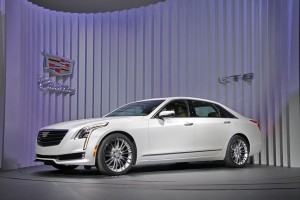With the launch of its 2016 CT6 sedan, Cadillac says it is setting out to “reinvent” itself, but some of the steps the maker has taken in the development of the new model will likely trigger changes across the industry.The new Cadillac CT6 is the same size as a big BMW 7-Series – but it weighs barely as much as the German maker’s smaller 5-Series sedan. In fact, the new Caddy flagship weighs less than its own midsize luxury sedan, the CTS.
“Lightweighting” has become one of the big buzzwords in today’s global auto industry as maker’s race to get the weight out of their vehicles.
The primary reason is to meet the tough new Corporate Average Fuel Economy, or CAFE, standards that will jump to 54.5 mpg by 2025. Mass, explains Cadillac Chief Engineer Dave Leone, “is the enemy of efficiency.”
Packing on the pounds also causes some of the same problems whether you’re an athlete or an automobile. Both are quicker and nimbler when they shed weight.
(For more on the new Cadillac CT6, Click Here.)
But it’s not quite as easy for automakers to put their products on a diet. The typical 2015 model is larger and better equipped than the same nameplate of a decade ago. And they have to meet tougher safety standards which also helps pack on the pounds.
So, to trim mass, automotive engineers have been turning to new, lightweight materials, such as aluminum. The completely redesigned Ford F-150 pickup, for example, averages about 700 pounds lighter than the older truck thanks to its “aluminum-intensive” body.
BMW took things even further with the debut of its battery-based sub-brand, BMW i. Both of its two new models, the i3 electric city car and i8 plug-in sports car, make extensive use of carbon fiber. That super-light, super-strong composite is also super-expensive, until now limiting its use to the likes of Formula 1 race cars and exotic vehicles from a Ferrari or Lamborghini.
(Over half of all cars to feature Stop-Start by 2024. Click Here for the new study.)
Steel has long dominated the auto industry and its suppliers aren’t about to fade off into the sunset. They’ve been developing new, ultra-strong versions of steel that can be made thinner – and much lighter for a given application.
That’s why the 2016 Cadillac CT6 will use a mix of aluminum, steel and other materials, notes the brand’s global president, Johan de Nysschen.
The goal, stresses the South African-born executive, was to come up with “the right materials for the right parts and components.”
Japanese maker Mazda underscores what auto engineers like to call a “systems approach.” By reducing the weight of a vehicle’s body and chassis they are cutting the size of suspension components, downsizing the engines used in new vehicles, even trimming a gram out of every lug nut. In the end, models like the latest Mazda CX-5 are adding several miles a gallon.
“Lightweighting is only part of the solution,” emphasizes David Cole, director-emeritus of the Center for Automotive Research in Ann Arbor, Michigan, but he quickly adds it is a critical part.
Part of the challenge, adds Dr. Cole, is keeping costs from running out of control. Aluminum is significantly more expensive than steel per pound – though an automaker needs less of it. The cost of carbon fiber is even more astronomical.
BMW has been working with a partner on developing new production methods that have begun driving down the cost of what is more formally known as carbon fiber-reinforced composites, or CFRPs. Together, they recently announced plans to expand a pilot facility in Washington States which will soon become the world’s largest producer of the advanced material.
Part of the challenge with new materials is that they often require very different production and assembly processes. Ford has spent over $1 billion retooling the two plants – near Detroit and Kansas City – that produce the F-150.
(Nissan lightweights new Maxima. Click Here for a closer look.)
Safety is another issue. The basic laws of physics suggest that if two otherwise identical vehicles collide, the lighter one will sustain the greater damage. No matter what you do, a Smart Fortwo will come out the loser in a battle with an 18-wheeler.
That said, while new materials such as aluminum and CFRP may be lighter than steel, they’re usually a lot stronger, pound-for-pound. Meanwhile, engineers have learned a lot about how to absorb and control crash forces, directing them away from the passenger compartment, even as advance safety systems such as airbags, make it possible to survive what once would have been a fatal collision.
How much lighter might tomorrow’s cars get? Over the last two years, it’s seemed like every new model has been shedding at least 100 pounds or more. But the DeltaWing concept could take things even further. Based on an experimental design that has been running on the endurance racing series, it blends advanced aerodynamics with super-light materials that could trim the weight of a conventional 4-seat sedan by half.
Under development by a Georgia-based start-up, it needs just a 1.4-liter, 138-hp engine to give V-6 performance – and is forecast to yield 74 mpg on the highway and 54 mpg combined. It hopes to have the concept in production before the end of the decade.
(A version of this story first appeared on NBCNews.com.)


Lighter is better in most situations, but not all. With mandated Federal impact bumpers and doors, more electronics, etc. the cars have gained a good 500 or more pounds in the past 5-10 years. Losing weight is always possible if consumers are willing to pay for exotic materials. The tiny gain in mpg from a few hundred pounds reduction on a 3500 lb. auto does not yield any tangible real world mpg gains but every little bit helps when you’re trying to meet the impossible 54.5 mpg CAFE requirement.